
“Tagging” is human nature—to separate a book into parts, then rebuild it in memory as a kaleidoscopic whole.
My son, an expert Googler, tried to explain to me the nature of tags. Since I’m by and large electronically illiterate, it took longer than he had expected, but in the end, I think I got it. In fact, I think I may have been able to track tagging back to its primordial roots.
The motto of human knowledge seems always to have been “Divide and Conquer.” Confronted with the bewildering, intricate reality in which we ourselves are enmeshed, our oldest ancestors must have tried to distinguish in that strange creature we call the universe, made up of trees and tigers and rivers and stones and stars, the separate entities that we call stars, stones, rivers, tigers and trees. Perhaps this need to see the parts in the whole is what lies behind the story in Genesis, of God bringing His creatures to Adam in order to be named. Perhaps God knew that Adam was incapable of perceiving in the tumultuous herd of fur and feathers and claws the singularities of God’s creation until each dog, each nightingale, each hippopotamus had received a proper name. Perhaps language is merely a tool for classifying the universe in order to see its parts.
A library, as Borges has taught us, is one of the names we give the universe, and shares with it its Gestalt quality. The earliest recorded libraries were born from a clash between two opposing ambitions: the ambition to collect and the ambition to categorize. As volumes piled up in the earliest Mesopotamian libraries, the earliest librarians struggled to find categories under which to list the books for identification. One of the oldest libraries we know of, an archive dating from the second millennium BCE, was discovered in 1975 by the archaeologist Paolo Matthiae. It stood in the city of Ebla, south of Aleppo, and was destroyed at least twice before 16 BCE. Here, among the ruins, Matthiae found lists or catalogues of the volumes collected, divided into myriad subjects such as kings of Ebla, commercial agreements, geographical sites, birds, metal and wooden objects, animals, gods, fish, professions, proverbs… We don’t know if these categories obeyed a hierarchy, but they certainly must have helped locate a specific volume on a specific subject.
The history of libraries is the history of the tagging of libraries. Whether by order of importance, as in the abbatial libraries of the Middle Ages where the Holy Scriptures occupied the first and supreme section, or in personal libraries, such as the mid-thirteenth-century collection of Richard de Fournival, who organized his books as in a flowerbed, starting with the blooms of philosophy and its offshoots; whether in the tenth-century Baghdad library catalogued by Ibn al-Nadim that included among its categories “The virtues and faults of all writers,” “Arab and foreigners” and “Existing in the Arab tongue,” or in Melvil Dewey’s late nineteenth-century decimal system in which God has the number 231; whether in the Cefu Yuangui, a Chinese catalogue prepared by a contemporary of al-Nadim’s, ordered according to bureaucratic status, from the Emperor downwards, or in the changing order established by Aby Warburg for his library in the early twentieth century, an order that followed the free associations of his wandering mind—all our labelling, without an accompanying explanation of its raison d’être, can be read as dreamlike poems composed by a reader in a trance.
Sometimes the logic behind such bibliographic categorizations can be glimpsed—alphabetical or chronological orders, by country or literary genre—but most of the time the reader’s tagging obeys rules that no one, sometimes not even the tagger, can explain. The endpaper pages of my books, where I jot down references I want to remember, consist of exactly such incoherent lists. Who can deduce that these tags—laughter, piano, wind, time, view or mirage, memory (lack of)—followed by page numbers, belong to my tattered copy of Buzzati’s The Tartar Steppe? Who could connect the words first violence, mirror, library, beauty of beloved, duchess, cock and come up with Don Quixote, Part I ? And yet, in these seemingly mad sequences of references, my reading (at least one of my readings) lies revealed.
Names, titles, labels attempt to do the impossible: select and encompass a book at the same time. “The swan of Avon” defines and does not define Shakespeare, just as the identification King Lear points at but fails to grasp the complex entirety of the play and just as Shakespeare’s summation of the Iliad, “the story of a cuckold and a whore,” is no doubt fair and yet tells us almost nothing about the book’s multitudinous contents.
Perhaps tagging is what all readers do: take apart the book in countless kaleidoscopic pieces and rebuild it in our memory as an ungraspable kaleidoscopic whole. In this—and my son agrees—lies our pleasure.








